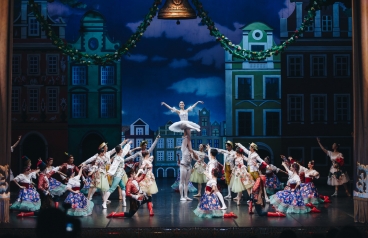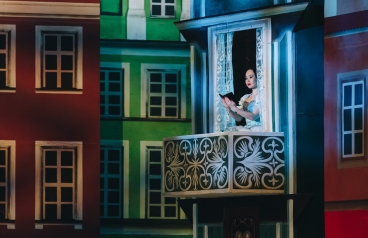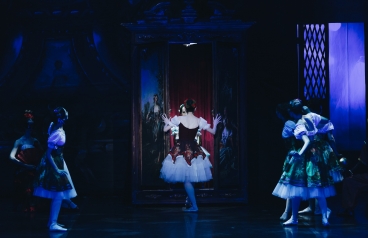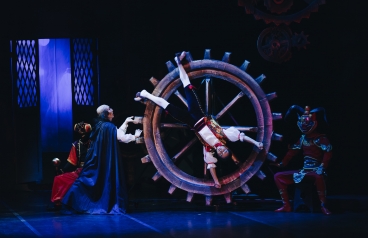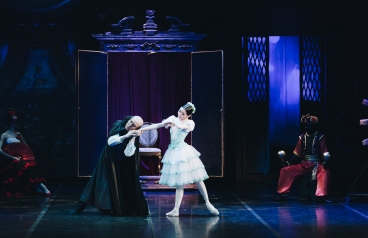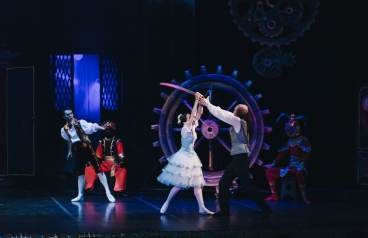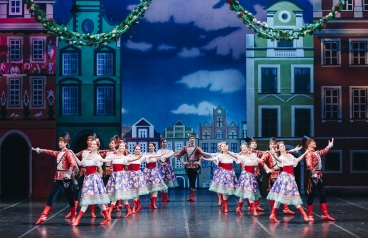COPPELIA

Léo Delibes
"Coppelia"
ballet in 2 acts
libretto by C. Nuitter and A. Saint-Leon
based on novels by E.T.A. Hoffman
choreography by M. Petipa and G. Tutkibayeva
Duration of the performance: 1 hour 45 minutes | Number of intermissions: 1 |
Age category: 5+
Characters:
Swanilda
Franz
Coppelius
Coppelia, the doll
The Burgomaster
Swanilda's friends
Franz's friends
Variations:
Morning
Day
Mazurka
Czardas
Symphony Orchestra and Ballet Company of Theatre
Production Team:
Stage Conductor - Yerbolat Akhmedyarov
Ballet Director - Gulzhan Tutkibayeva, People's Artist of the Republic of Kazakhstan
Production Designer - Vyacheslav Okuknev, People's Artist of Russia, Laureate of State Awards
History
The premiere of the performance at the Abay SATOB took place on May 20, 21, 2017
"Coppelia, or Girl with Blue Eyes" - a ballet to the music of the French composer Leo Delibes refers to the genre of the comic performance, rare on the ballet stage.
"Coppelia" is a recognized standard of classical ballet, which is included in the repertoire of almost all the famous theaters and ballet troupes.
Today, the original choreography of the ballet is almost forgotten, and the ballet continues to live, gaining new colors and new readings. The reason for this is the wonderful music of Leo Delibes, which brought the ballet theater to a new path. Music ceased to be a "servant of choreography", turning into an equal component of the performance. The art of the author was admired by P.I. Tchaikovsky. “What a charm, what grace, what riches melodic, rhythmic, harmonious,” wrote the great Russian composer.
The ballet "Coppelia" became a milestone in the work of the composer. He began working on it in 1869. In this ballet, the composer skillfully uses action films characterizing the main characters, which contributes to the dramatic unity. Ballet music is poetic, emotionally expressive, figurative and plastic. It clearly contrasts the world of living human senses and the world of soulless doll mechanisms.
In some dances (Polish Mazurka, Hungarian Chardash, Scottish Gigue, etc.), the composer uses the features of national folklore. The most vividly depicted by the composer is the image of Svanilda, capricious, playful, pensive, tender. The Waltz of Svanilda from Act 1 is the most famous ballet number, often performed on the concert stage in a vocal version.
This ballet has interesting classical and characteristic dances. And also a kind of pontomime.
The main storyline of this comic ballet, oddly enough, was taken from Hoffmann's completely gloomy short stories, mainly from Sandman. At Hoffmann, the young man’s hobbies with a doll end tragically - and in ballet - a happy ending.
Coppelia saw the light of the ramp in 1870. at the Paris Opera. Its creator was Arthur Saint-Leon - a choreographer, as well as a virtuoso dancer, an expert in dance folklore, a composer and violinist. His substantive interest in the "dances of the peoples of the world" caused the appearance in the musical score of such a yogaty "set" of melodies based on dance folklore.
Until the end of the IXI century, ballet was staged in New York, London, Brussels, Milan, Copenhagen, Munich, Moscow, St. Petersburg. The 20th and 21st centuries also paid tribute to this ballet, sometimes offering modern readings with a tragic denouement.
The ballet "Koppelia" was staged at the Abay GATOB in 1937 by the choreographer Yuri Kovalev. And after 80 years, May 20, 2017 “Coppelia” again became a wonderful decoration of the repertoire. Directed by Gulzhan Tutkibaeva, the ballet acquired new colors, combining classical and neoclassical choreography.

